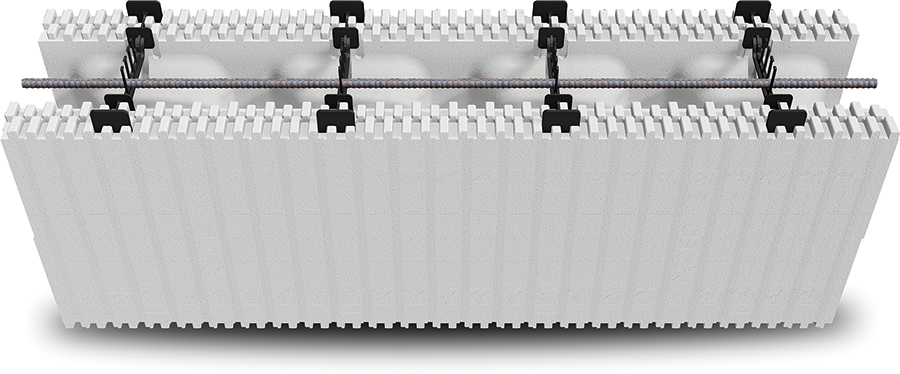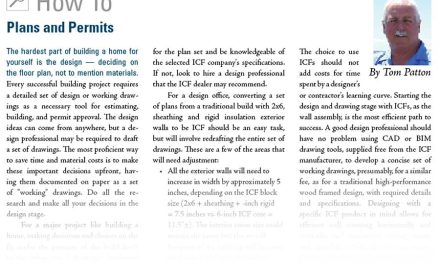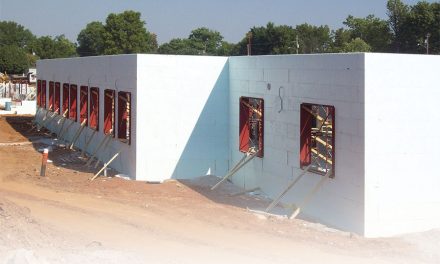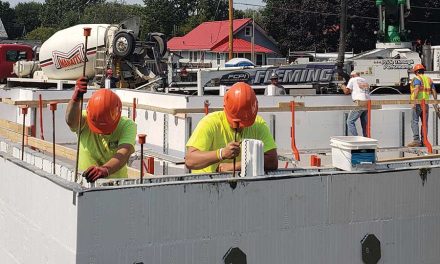A majority of ICF companies provide forms with concrete core sizes at 4, 6, 8, 10, and 12 inches. The range allows for different applications and engineering design criteria. The structural advantage of reinforced concrete design allows for thinner walls than those required for regular poured concrete or concrete block walls. This provides a huge savings in not only concrete costs, but in installation labor, especially for foundation walls. The concrete core size engineering follows three main design attributes—below grade walls, above grade walls, and lateral support.
Below grade walls are foundation walls that retain earth and supports a structure of either wood framing or concrete. A crawl space or stem wall is designed as a below grade wall. For residential construction, a 6- or 8-inch core size is typically used. A 4-inch ICF concrete core cannot be used for below grade walls.
Above grade walls are any walls that do not retain earth. Above grade walls may be built on slabs, grade beams, or ICF foundations. For above grade, typically a 4- or 6-inch core size is used. Different design variables but these are easily met by ICF reinforced concrete walls. The IRC (International Residential Code) tables list walls up to 10 feet high between lateral supports. ICF manufacturers may have engineering tables for walls higher than 10 feet.
Lateral support is the measurement between support connections of the ICF wall. In the IRC code tables this distance is identified as the Unsupported Wall Height. The distance between these support connections, or unsupported wall is what is used in the design tables. For above grade walls, similarly the distance between floor connection or the floor and roof connection is the lateral support distance. For foundation walls that exceed the 10-foot height between lateral supports, project specific engineering would be required or check with your ICF manufacturer for an engineered design.
In most areas a 6-inch ICF reinforced foundation wall meets the IRC requirements. In some areas, local building codes state that foundation walls must be a minimum of 8 inches of concrete. In these regions an 8-inch concrete core is required.
As the design variables increase, the rebar layout increases, and as the concrete core size increases, the rebar layout decreases. Since rebar is cheaper than concrete, look to selecting an acceptable thinner concrete core.
For homes with a great room or large foyer, these above-grade walls may be two stories high between lateral supports. Here, an 8-inch concrete core is required, but the remainder of the home could use a 6-inch concrete core. Design the transition change in wall thickness at an appropriate spot. General rule for ICF concrete core sizes on above grade residential walls:
- 4-inch limited to one-story, 10 foot high
- 6-inch may be multiple stories up to 14 feet high between lateral supports
There are a few additional design attributes that may influence the core size and the reinforcement layout.
Seismic – In high seismic zones larger core sizes may be required to add double layers of rebar. 4-inch concrete cores may not be applicable moving up to 6 or 8 inches.
High Wind Areas – A 6-inch ICF wall assembly has been tested for wind speeds over 200 mph and for construction of FEMA approved safe rooms.
Resiliency – A 6-inch ICF reinforced concrete core has passed testing for high winds, flying debris, and 4-hour fire resistance. ICFs have proven experience surviving tornadoes, floods, and wildfires.
Energy Efficiency – The thermal rating of an ICF wall assembly is provided mainly by the double EPS insulation layers. Concrete has an R-value of 0.06 per inch—increasing the core size adds to the thermal mass of the wall but does very little to improve the overall R-value of the wall assembly.
Constructability – The best scenario in any build is to use the same size concrete core block from the footings to the roof. This simplifies ordering and the overall build. As mentioned, the foundation wall and above grade walls don’t necessarily have to be the same size. The foundation may be 8-inch concrete core while above grade the walls could be 4- or 6-inch concrete core. This allows for considerable cost saving on concrete. In a comparison for 120 linear feet of wall 8 foot high, the concrete quantities would be:
- 4-inch ICF = 11.8 cu yd • 6-inch ICF = 17.78 cu yd
- 8-inch ICF = 23.7 cu yd • 10-inch ICF = 29.63 cu yd
The difference could be an extra $1,000 for block and concrete.
Conclusion
Read the IRC building code tables in Section 4 and 6 or follow the manufacturer’s recommended engineering design tables. ICFs have a built-in advantage being a reinforced concrete wall which does allow for thinner concrete designs. For residential construction in most areas, a 6-inch concrete core is typical for the whole build. In the areas with no basements, slab on grade construction, a 4-inch above grade wall will meet most designs. In some areas foundation walls must be a minimum 8 inches of concrete. Any walls that exceed the applicable limits as set out in the building for residential design must be designed by an engineer.

Tom Patton
Tom Patton had a 30-year architectural design background prior to joining the ICF industry in 2001. Since then, Tom has worked with major ICF companies developing technical documentation, application details, and training programs, as well as consulting and promoting ICFs with various associations including the ICFMA, NRMCA, and codes and standards committees. Currently, Tom is Corporate Brand Ambassador for Fox Blocks and co-developer of the Fox Blocks Integrated Learning Center.














I need a structure very strong, but particularly the basement should be able to withstand a powerful bomb 200 miles away.